From funeral potatoes to fry sauce, I ate my way through Utah on my first visit to the state. The food was so good, I'll be back for seconds.
Monica Humphries

- I ate and sipped my way through Utah on a recent road trip through the state.
- I tried classics that are common in the state, like funeral potatoes and dirty sodas.
There's Key lime pie in Florida, green chile in Colorado, and deep-dish pizza in Illinois. Almost every state has a dish that's unique to its region. Utah is no exception.
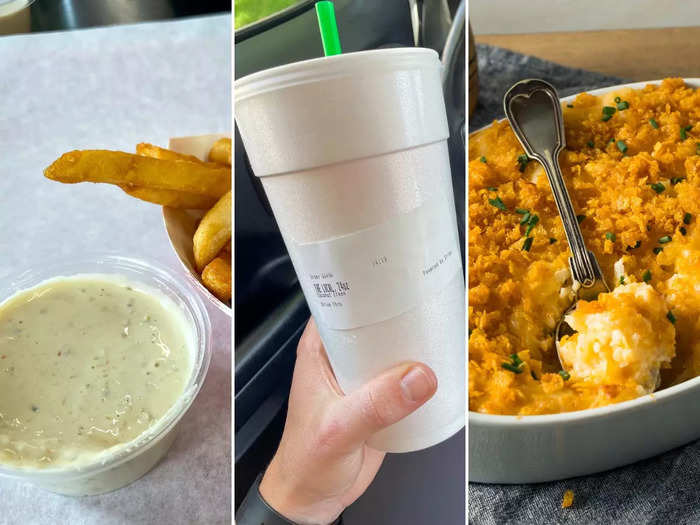
I venture out in planes, trains, and cars to explore monuments, natural wonders, and more — all in the name in journalism. I also travel for food.
Last month, I took a train from Denver, Colorado, to Utah. There, I rented a car for five days and ate as much as possible as I explored the state's popular cities like Moab and Salt Lake City.
With the state's large Mormon population and Indigenous land, food and drinks of all forms have originated in Utah.
For five days, I ate and sipped my way through the Beehive State.
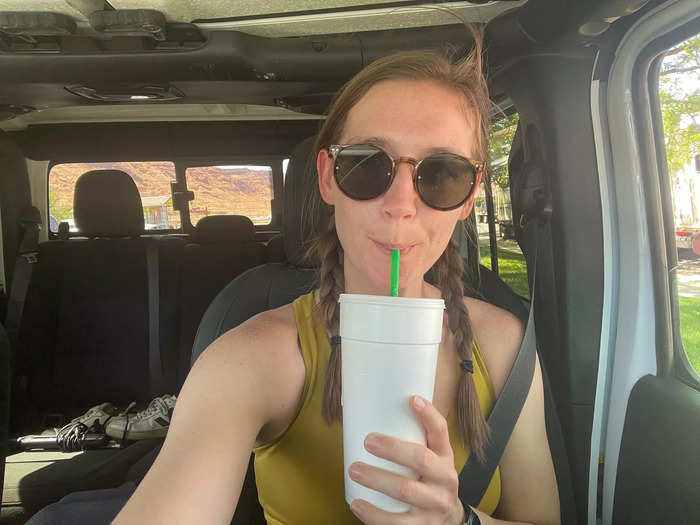
As someone who had never been to Utah before, I was excited to try many of the state's staples on my trip. I popped into bars in Salt Lake City, I sat in soda drive-thru lanes in Moab, and I devoured fried desserts from the driver's seat of my rental car. (Insider paid for all of these meals, per our reporting standards.)
I tracked down a Salt Lake City bar serving a vegetarian version of funeral potatoes.
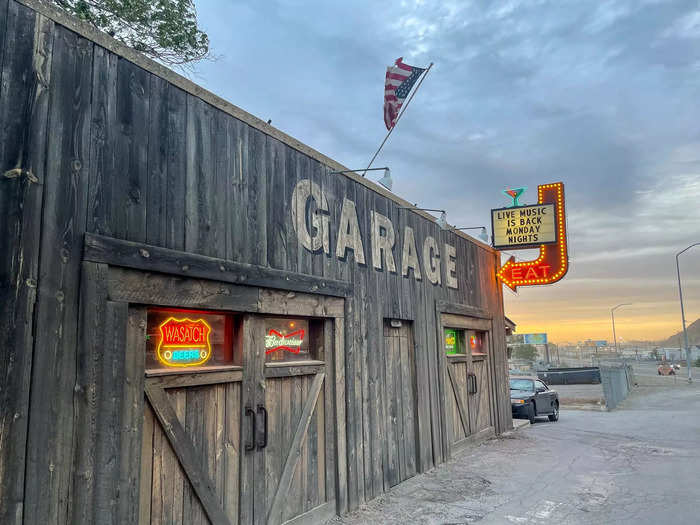
Typically served in casserole form, funeral potatoes consist of potatoes (of course), cheese, creamy soup, and crushed cornflakes, according to Utah's KTVX. However, some argue it should be made with potato chips instead of cornflakes, as Deseret News reported.
While the origins of the cheesy dish are unclear, according to Deseret News, it is a staple for members of the Church of Jesus Christ of Latter-day Saints.
Simply put, funeral potatoes are Utah comfort food. And as the name implies, you're more likely to find funeral potatoes at a funeral, family reunion, or luncheon than at a restaurant.
Although a handful of restaurants do serve traditional funeral potatoes as a side, the ones I found all included bacon. Since I don't eat meat, I tracked down a vegetarian version of the dish at Garage on Beck in Salt Lake City.
While they weren't traditional funeral potatoes, they were delicious enough that I'd try making the casserole version at home.
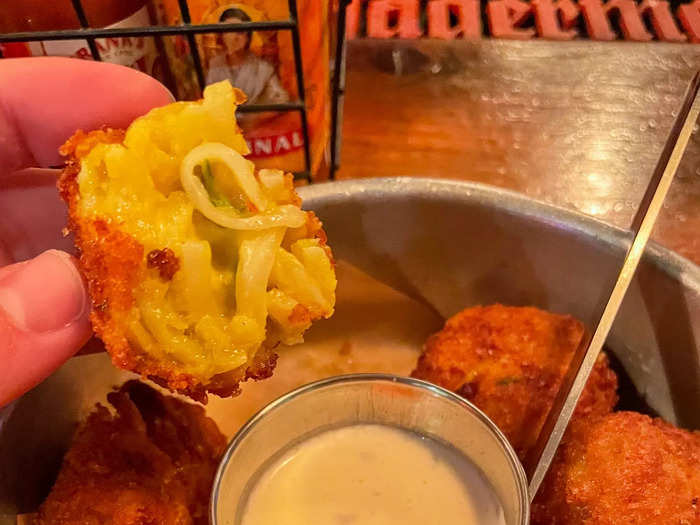
Garage on Beck dishes out a nontraditional version of funeral potatoes. Instead of a casserole dish, as they're typically made, the bar's funeral potatoes are served in deep-fried ball form.
Each little ball is made up of Idaho potatoes, cheddar cheese, jalapeño, and scallions. They're rolled in a cornflake crust and "baptized in hot oil," the menu states. Diners can choose between a vegetarian version, a fiery version, and a regular version that includes bacon.
I opted for the vegetarian version, which cost $12.
Six funeral potato balls came out on an aluminum dish with a side of "Utah ranch," which tasted to me like blue cheese.
I cut open the first ball, and steam immediately seeped out. The funeral potatoes were creamy, and each ball had an Instagrammable cheese pull.
I went in for a first bite and immediately realized why the dish earned its label as comfort food.
The crunch exterior paired well with the soft interior. It was filling, it was warm, and it was anything but healthy.
While I couldn't eat six in one sitting, I'd happily hunt down a vegetarian recipe and bring it to my next cookout.
I had to visit Utah's carbonated, sugary soda shops.
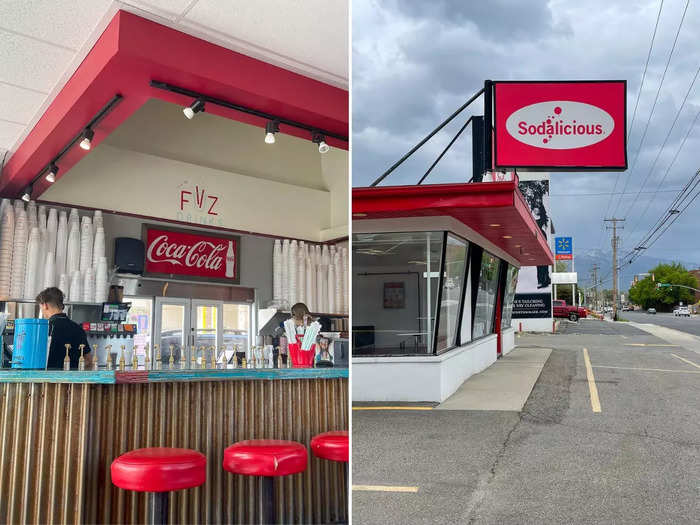
I found more soda shops than coffee shops in my five days in Utah.
Since 2012, soda-shop chains have popped up selling concoctions of carbonated drinks and flavored syrups.
The soda shops can be traced back to Utah's Mormon population.
In the Church of Jesus Christ of Latter-day Saints, alcohol, tobacco, and hot caffeinated drinks like tea and coffee are prohibited, according to The Washington Post. But after the church clarified that cold caffeinated drinks like soda are allowed in 2012, a soda-shop trend emerged, Vice reported. As of December, there were more than 100 stores solely selling soda in the state, according to The New York Times.
I'll admit that every now and then I crave a cold Coke with a thin slice of New York-style pizza, but I rarely drink soda on a regular basis.
But I was in Utah and wanted to see what the buzz was about, so I stopped at Lop's Pop Stop in Moab and soda chains Sodalicious and FiiZ Drinks in Salt Lake City.
I stopped at three stores and gulped down six sodas. It's still not for me, but I can see the appeal.
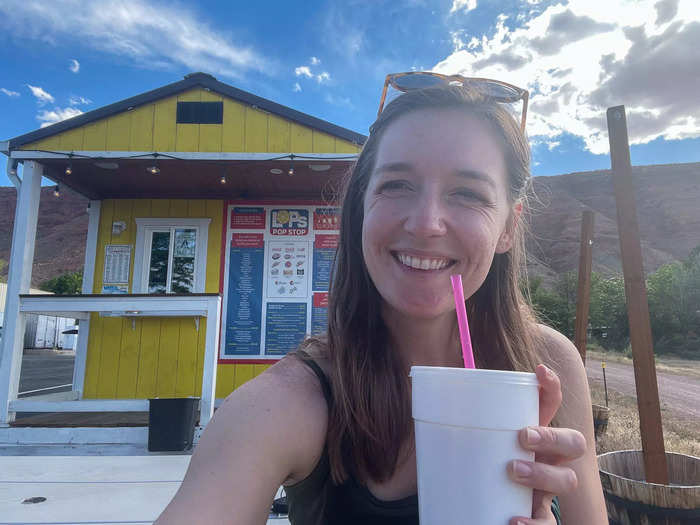
For five days, I consumed carbonated drinks teeming with coconut cream and flavored syrups.
I tried everything from Diet Coke mixed with coconut cream and lime to a "Captain Jack Sparrow," which had Dr. Pepper with cream, coconut, pineapple, and raspberry syrup.
I wanted to decide what makes a good "dirty soda," which is the nickname for these flavored drinks. Ultimately, it came down to drinks with flavored syrup that didn't overpower the taste of the original soda.
The drinks were tasty and cheap — no soda cost me more than $3.15. But by the end of the trip, I was waiting for a sugar crash to hit.
I knew I needed to try fry sauce in Utah, so I gave it a chance at Moochie's Meatballs.
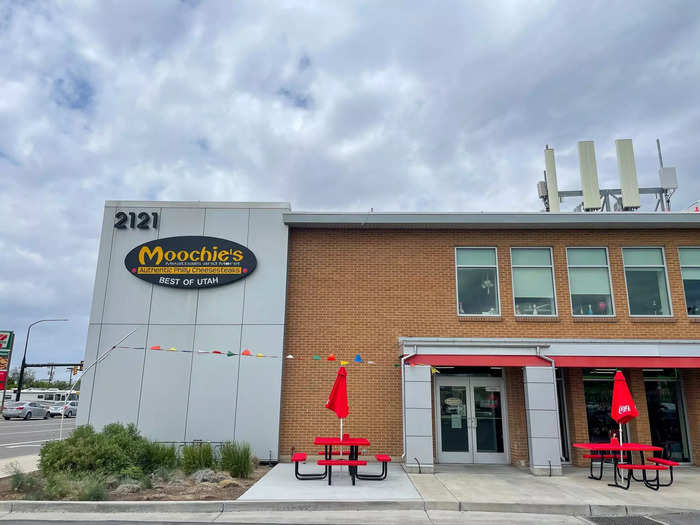
Leading up to my trip, I had heard murmurs about fry sauce. A friend swore it was the best dipping sauce for anything fried, while outlets like Eater have said there's "nothing more tantamount to the state of Utah than an ambiguous mixture of ketchup and mayonnaise."
The sauce — one part mayo, one part ketchup, and some seasoning — was created by Salt Lake City Chef Don Carlos Edwards in the 1950s, according to Utah's KTVX.
While it's served across the entire state, I decided to give fry sauce a try at the fast-food chain Moochie's Meatballs and More in Salt Lake City.
After trying fry sauce, I personally don't understand the hype.
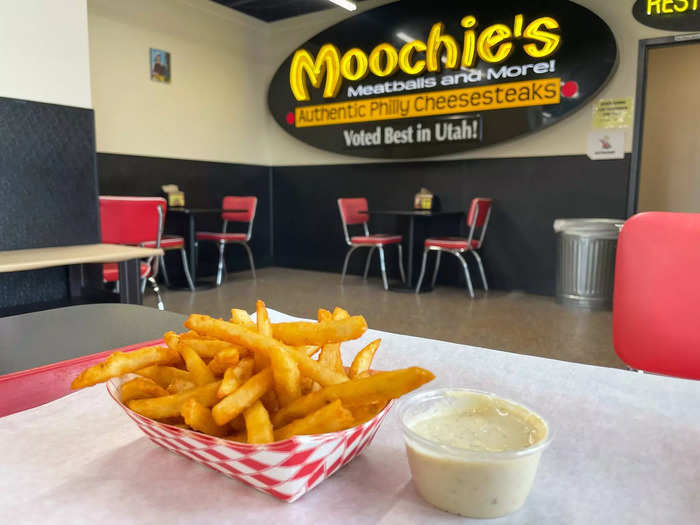
After spotting rows of squeeze bottles in a fridge in the corner of Moochie's — apparently, its fry sauce is so popular that customers buy it in bulk — I was eager to try the beloved sauce.
I ordered the fries, which cost $1.99, and double-checked that they came with fry sauce — which, of course, they did. My plastic tray arrived with a platter of crispy fries and two to-go containers of fry sauce. I opened my container and spotted a thick, creamy sauce with flecks of seasoning.
I'm no mayo or ketchup hater, but the fry sauce didn't wow me. I thought it was slightly tangy, heavy on the mayo, and not spicy as Moochie's said its version would be.
In my opinion, there just wasn't enough flavor for me. I'd leave behind the thick, tangy dipping sauce and trade it for ketchup any day.
Fry bread was another must-eat on my trip. Navajo Hogan was one of only a few restaurants I could find serving the Indigenous comfort food.
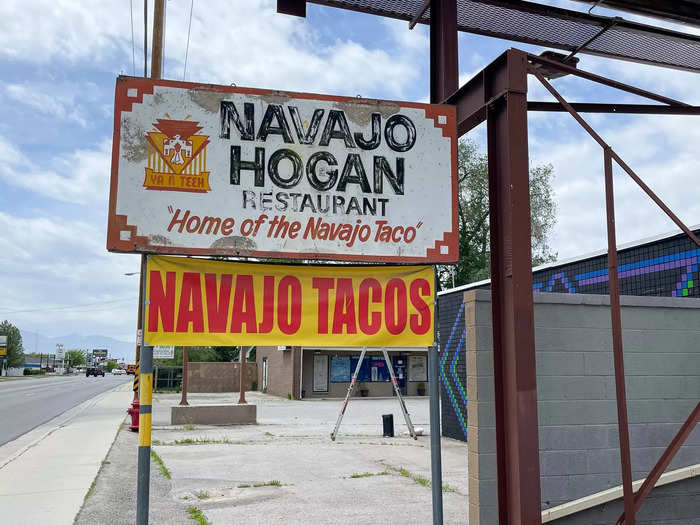
As Kevin Noble Maillard writes for The New York Times, fry bread is commonly understood to have originated as a "survival food, usually traced to the Navajo people (who call themselves the Diné)."
When Indigenous people were forced from their homes and ancestral lands by the US government, the food they ate was also forced to change. Indigenous people no longer had access to fresh ingredients and turned to government-rationed nonperishables, according to The New York Times, so with limited ingredients like flour, salt, baking soda, and oil, they made dough, cooked it in oil, and fry bread was born.
The dish slowly became a staple in Indigenous communities, and today, it's served across the Navajo Nation and American West, The New York Times reported. However, the dish is also a subject of debate as some Indigenous food activists and academics "seek to decolonize Indigenous diets from the high-fat, high-calorie attractions of fry bread," according to The New York Times.
In Salt Lake City, a few places serve fry bread including Navajo Hogan, which opened in 1989 and is owned by Bill Espinoza and his wife Marcie.
Fry bread is used as the base for Navajo tacos, which I ordered at Navajo Hogan.
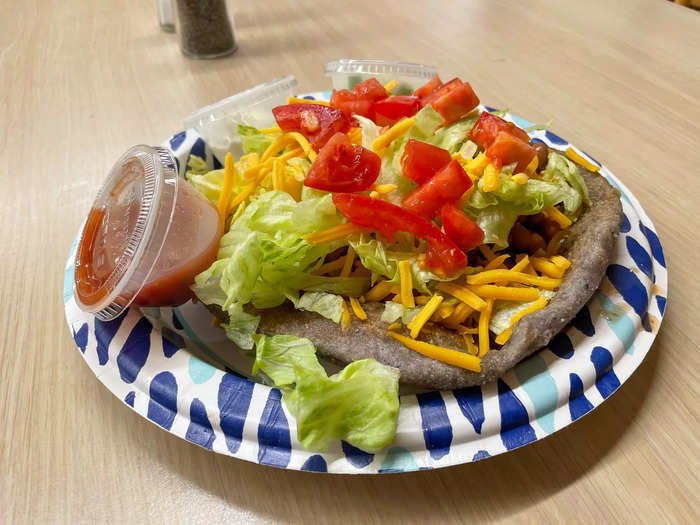
I ordered a vegetarian Navajo taco, which came with dessert fry bread and a soda for $13.38. I took a seat and in minutes the dish was in front of me on a paper plate.
The taco had a blue-corn fry bread base. Piled on top were chili beans, lettuce, tomatoes, and cheese. Three plastic to-go containers also came out filled with salsa, sour cream, and jalapeños.
It was delicious. The fry bread had a fluffy, warm interior and crunchy exterior, which felt like the perfect combination between a soft and hard shell taco.
As I left the restaurant, I asked the person at the counter what makes fry bread so tasty. She told me that it's all about the proportions of ingredients and it also has to have "lots of love."
I walked away full and planning to save my dessert fry bread for later. Then, I accidentally consumed the entire thing in the front seat of my car.
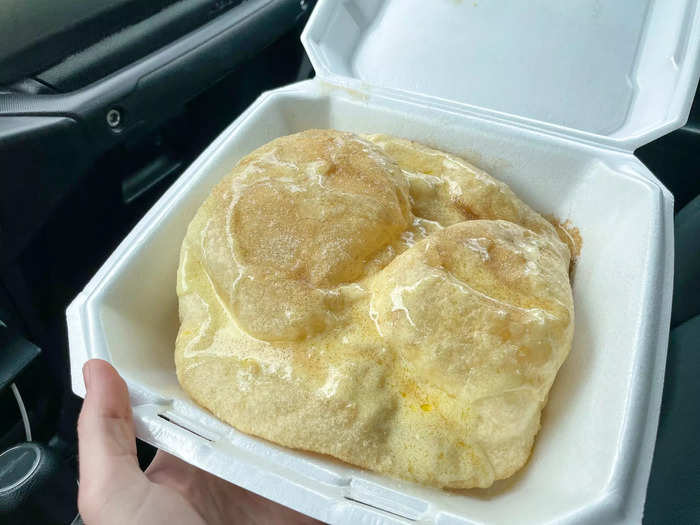
Full from my meal, I got my dessert fry bread to go. And as I hopped in my car to head back to my hotel, my car instantly smelled like cinnamon sugar.
I hadn't planned to eat the fry bread right away, but I figured a peek in the Styrofoam container wouldn't hurt.
As I lifted the lid, a bubbly, glistening dough came into view. The mammoth piece of fry bread was covered in melted honey butter and sprinkled with cinnamon sugar.
It was still warm, so I obviously took a bite. Then, I proceeded to eat the entire fry bread in the restaurant parking lot.
I hadn't tasted anything like it before; it was like a combination of a funnel cake and churro — but better. Weeks later, I still think about the warm, sugary fry bread.
While I might not come back to Utah for its fry sauce, I won't visit without picking up sweet fry bread from Navajo Hogan.
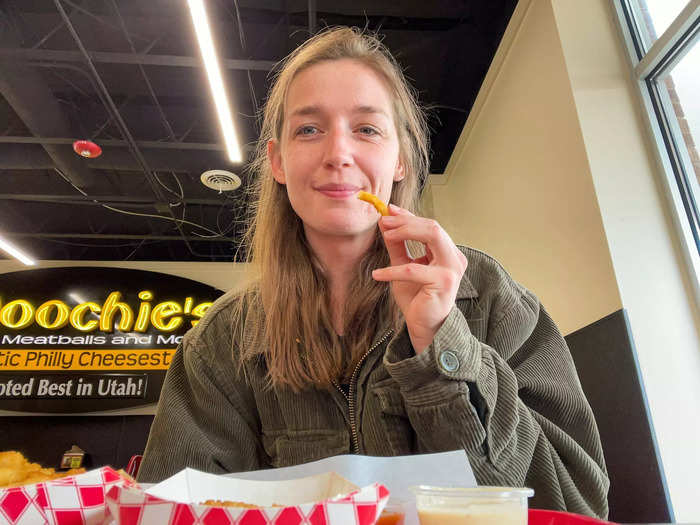
I left the state happy and full. Plus, I had a few recipes to bring home and a few reasons to come back to the Beehive State.
READ MORE ARTICLES ON
Popular Right Now
Popular Keywords
Advertisement